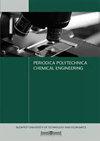离子交换和模拟的工业应用研究
IF 1.8
4区 工程技术
Q3 ENGINEERING, CHEMICAL
引用次数: 0
摘要
我们研究了离子交换技术的工业应用以及固定床多组分离子交换过程的建模。在本文中,我们报告了这两个研究领域的情况。我们开发了一种复杂的技术,用于从放射性蒸发器底部残留物中选择性分离长效放射性核素和部分回收硼酸。我们利用铯选择性无机离子交换器开发了一种废水处理系统。从帕克斯核电厂的高浓度盐和强碱性蒸发器底部残渣中选择性分离 137Cs、134Cs,在去污系数 DF > 100 的情况下,对核电厂四个蒸发器底部残渣罐的样本进行处理,体积减少系数约为 3500-6500 。一些重要类别的离子交换剂确实具有均匀的内部孔隙结构,并能使溶质结构的所有部分与液体更紧密地接触。这类材料是多孔有机树脂。针对这些类型的交换器,我们修改了曼苏尔的多组分吸附模型,并开发了一套计算机程序,用于描述离子交换器的多组分突破、共流和逆流洗脱曲线。此外,我们还开发了根据 Nernst-Planck 方程计算多组分离子交换动力学的子程序,并成功进行了测试。这个子程序将被添加到多组分离子交换突破和洗脱模拟程序中,从而形成一个真正的多组分离子交换模拟程序。本文也报告了这些研究成果。本文章由计算机程序翻译,如有差异,请以英文原文为准。
Research in Industrial Use of Ion Exchange and Simulation
We investigated the industrial use of ion exchange technology as well as the modeling of fixed bed, multicomponent ion exchange processes. In this paper we report on both fields of this research. We have developed a complex technology for the selective separation of the long-live radionuclides and the partial recycling of boric acid from radioactive evaporator bottom residue. A wastewater treatment system has been developed by using a cesium-selective inorganic ion exchanger. The selective separation of 137Cs, 134Cs from high salt concentration and strongly alkaline evaporator bottom residue in Paks NPP has a volume reduction factor of about 3500–6500 at the value of the decontamination factor DF > 100, for the samples of four evaporator bottom residue tanks of the NPP. Some important classes of ion exchangers do possess uniform internal pore structures and bring all parts of the solíd structure into much closer contact with the liquid. Such materials are porous organic resins. For these types of exchangers, we have modified Mansour's multicomponent adsorption model and developed a computer program to describe multicomponent breakthrough, cocurrent, and counter-current elution curves for ion exchangers. In addition, we have developed a subroutine for the calculation of multicomponent ion exchange kinetics according to Nernst-Planck equation and successfully tested it. This subroutine will be added to the multicomponent ion exchange breakthrough and elution simulation program to have a real multicomponent ion exchange simulation program. In this paper we report about these research results too.
求助全文
通过发布文献求助,成功后即可免费获取论文全文。
去求助
来源期刊

Periodica Polytechnica Chemical Engineering
ENGINEERING, CHEMICAL-
CiteScore
3.10
自引率
7.70%
发文量
44
审稿时长
>12 weeks
期刊介绍:
The main scope of the journal is to publish original research articles in the wide field of chemical engineering including environmental and bioengineering.
 求助内容:
求助内容: 应助结果提醒方式:
应助结果提醒方式:


